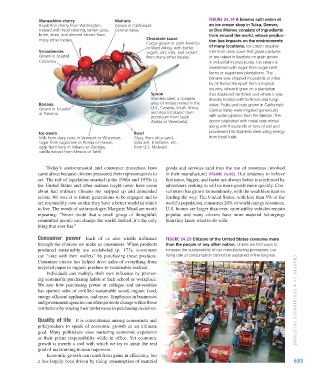Page 686 - Environment: The Science Behind the Stories
P. 686
Maraschino cherry Walnuts Figure 24.19 A banana split eaten at
Royal Ann cherry from Washington, Grown in California’s an ice cream shop in Tulsa, Denver,
treated with food coloring, lemon juice, Central Valley or Des Moines consists of ingredients
brine, alum, and almond extract from from around the world, whose produc-
many other locales Chocolate sauce tion has impacts on the environments
Cocoa grown in Latin America
or West Africa, with butter, of many locations. Ice cream requires
Strawberries sugars, salt, milk, and extract milk from dairy cows that graze pastures
Grown in coastal from many other locales or are raised in feedlots on grain grown
California in industrial monocultures. Ice cream is
sweetened with sugar from sugar beet
farms or sugarcane plantations. The
banana was shipped thousands of miles
by oil-fueled transport from a tropical
country, where it grew on a plantation
Spoon that displaced rainforest and where it was
Stainless steel, a complex liberally treated with fertilizers and fungi-
Banana alloy of metals mined in the cides. Fruits and nuts grown in California’s
Grown in Ecuador U.S., Canada, South Africa, Central Valley were irrigated generously
or Panama and Asia (or plastic from with water piped in from the Sierras. The
petroleum from Saudi
Arabia or Venezuela) spoon originated with metal ores mined
along with thousands of tons of soil and
Ice cream Bowl processed into stainless steel using energy
Milk from dairy cows in Vermont or Wisconsin; Glass, from silica sand, from fossil fuels.
sugar from sugarcane in Florida or Hawaii; soda ash, limestone, etc.,
eggs from hens in Indiana or Georgia; from U.S. Midwest
vanilla extract from Mexico or Tahiti
Today’s environmental and consumer protection laws goods and services (and thus the use of resources involved
came about because citizens pressured their representatives to in their manufacture) (Figure 24.20). Our tendency to believe
act. The raft of legislation enacted in the 1960s and 1970s in that more, bigger, and faster are always better is reinforced by
the United States and other nations might never have come advertisers seeking to sell us more goods more quickly. Con-
about had ordinary citizens not stepped up and demanded sumption has grown tremendously, with the wealthiest nations
action. We owe it to future generations to be engaged and to leading the way. The United States, with less than 5% of the
act responsibly now so that they have a better world in which world’s population, consumes 20% of world energy resources.
to live. The words of anthropologist Margaret Mead are worth U.S. homes are larger than ever, sport-utility vehicles remain
repeating: “Never doubt that a small group of thoughtful, popular, and many citizens have more material belongings
committed people can change the world. Indeed, it’s the only than they know what to do with.
thing that ever has.”
Consumer power Each of us also wields influence Figure 24.20 Citizens of the United States consume more
through the choices we make as consumers. When products than the people of any other nation. Unless we find ways to
produced sustainably are ecolabeled (p. 173), consumers increase the sustainability of our manufacturing processes, our
can “vote with their wallets” by purchasing these products. rising rate of consumption cannot be sustained in the long run.
Consumer choice has helped drive sales of everything from
recycled paper to organic produce to sustainable seafood.
Individuals can multiply their own influence by promot-
ing sustainable purchasing habits at their school or workplace.
We saw how purchasing power at colleges and universities
has spurred sales of certified sustainable wood, organic food,
energy-efficient appliances, and more. Employees in businesses
and government agencies can often promote change within those CHAPTER 24 • Su STA in A bl E Sol u T i on S
institutions by voicing their preferences in purchasing decisions.
Quality of life It is conventional among economists and
policymakers to speak of economic growth as an ultimate
goal. Many politicians view nurturing economic expansion
as their prime responsibility while in office. Yet economic
growth is merely a tool with which we try to attain the real
goal of maximizing human happiness.
Economic growth can result from gains in efficiency, but
it has largely been driven by rising consumption of material 685
M24_WITH7428_05_SE_C24.indd 685 13/12/14 10:40 AM

